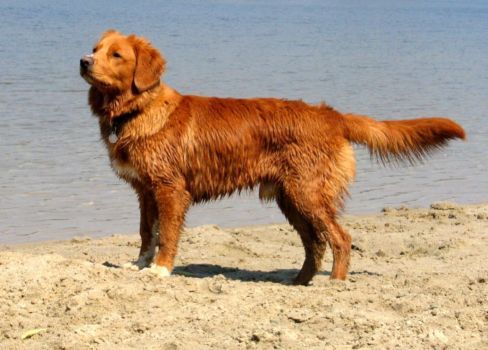- Nova Scotia Duck-Tolling Retriever
Infobox Dogbreed
akcgroup = Sporting
akcstd = http://www.akc.org/breeds/nova_scotia_duck_tolling_retriever/index.cfm
altname = Yarmouth Toller
Tolling Retriever
Little Red Duck Dog
Little River Duck Dog
ankcgroup = Group 3 (Gundogs)
ankcstd = http://www.ankc.aust.com/novascot.html
ckcgroup = Group 1 - Sporting Dogs
ckcstd = http://www.ckc.ca/en/Default.aspx?tabid=99&BreedCode=RNS
country =Canada (Nova Scotia )
fcigroup = 8
fcinum = 312
fcisection = 1
fcistd = http://www.dogdomain.com/fcistandards/fci-312.htm

image_caption = Tolling Retriever
kcukgroup = Gundog
kcukstd = http://www.thekennelclub.org.uk/item/110
name = Nova Scotia Duck-Tolling Retriever
nickname = Toller, Scotty
nzkcgroup = Gundog
nzkcstd = http://www.nzkc.org.nz/br326.htmlukcgroup = Gun Dogs
ukcstd = http://mail.ukcdogs.com/UKCweb.nsf/80de88211ee3f2dc8525703f004ccb1e/65d4145abfcaf19b852570460062a5db?OpenDocument The Nova Scotia Duck-Tolling Retriever is one of the most unusual breeds ofgundog , at least in terms of how the dog works. The hunter stays hidden in a blind and sends the dog out to romp and play near the water, usually by tossing a ball or stick to be retrieved. The dog's activity and white markings pique the curiosity ofwaterfowl , who swim over to investigate. The act of enticing or luringgame to approach is known as "tolling". When the birds are close, the hunter calls the dog back to the blind, then rises, putting the birds to flight, allowing him a shot. The Toller then retrieves any downed birds.Description
Appearance
According to the
breed standard s, the Toller should be athletic, well-muscled, compact, medium boned, balanced and powerful. The chest is deep. Conformation judges require Tollers to be capable of tolling, and physical faults that inhibit working ability are heavily penalized. They should be of moderate build—a lack of substance or a heavy build are penalized by judges, as both detract from the type and athleticism. The legs are sturdy and solid.Those who breed Tollers for
conformation show s consider the head (clean cut, slightly wedge-shaped) to be an important feature, and believe it should resemble that of a fox and must never be blocky like that of aGolden Retriever . The ears are triangular and set high and well back from the skull.The tail is well-feathered and held jauntily when the dog is excited or moving.
Coat and color
Color is any shade of red, ranging from a golden red through dark coppery red, with lighter featherings on the underside of the tail, pantaloons, and body. Even the lighter shades of golden red are deeply pigmented and rich in color. The Toller should not be buff or
brown .The Toller has usually at least one of the following white markings - tip of tail, feet (not extending above the
pastern s) chest and blaze. Lack of white is not a fault."The Toller was bred to retrieve from icy waters and must have a water-repellent double coat of medium length and softness, and a soft dense undercoat. The coat may have a slight wave on the back, but is otherwise straight. Some winter coats may form a long loose curl at the throat. Featherings are soft and moderate in length. The hair on the muzzle is short and fine. Seasonal shedding is to be expected."http://www.akc.org/breeds/nova_scotia_duck_tolling_retriever/index.cfm The American Kennel Club: Nova Scotia Duck Tolling Retriever Breed Standard. Retrieved May 31, 2008] Over-coated specimens are not appropriate for a working dog.
ize and proportions
Tollers are the smallest of all the retriever breeds. Tollers range in height from 20 to 23 inches at the
withers , and weigh 37 to 51 pounds (17-23 kg);http://www.ankc.aust.com/novascot.html Australian National Kennel Council: Nova Scotia Duck Tolling Retriever Breed Standard. Retrieved May 25, 2007] females are slightly shorter and lighter. Tollers are always a medium-sized breed, never large, however there has been a trend towards larger dogs in recent years.Tollers should be slightly longer than tall (a ratio of approximately 10 to 9). However, they should not be appear long-backed either.
Temperament
"The Toller is highly intelligent, alert, outgoing, loving, and ready for action, though not to the point of nervousness or hyperactivity. It is affectionate with family members and is good with children, showing patience. Some individuals may display reserved behavior in new situations, but this is not to be confused with shyness... The Toller's strong retrieving desire coupled with his love of water, endurance and intense birdiness, is essential for its role as a tolling retriever."http://www.akc.org/breeds/nova_scotia_duck_tolling_retriever/index.cfm The American Kennel Club: Nova Scotia Duck Tolling Retriever Breed Standard. Retrieved May 31, 2008]
Care
Tollers need to be brushed with a pin brush and slicker once to twice a week. On show dogs, the long hair ears is trimmed with thinning scissors. The coat may require occasional professional attention. Tollers are extremely active and need about an hour's worth of exercise a day, whether it's by biking, romping in a field, swimming, or just going on a walk.
Health
Tollers are generally hardy. However, they, like almost all dog breeds, have certain
genetic disorder s that are prevalent in the breed. This is sometimes blamed on a relatively smallgene pool , a problem that is aggravated because some people buying Tollers only want dogs that are bred in Nova Scotia, believing that Nova Scotian dogs are the only "true" Tollers. The Toller's hereditary diseases include:*
Addison's Disease
*Progressive retinal atrophy
* Hip dysplasiaThe average life span is about 11-15 years.
History
Wikimedia Foundation. 2010.
